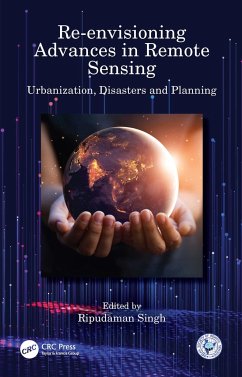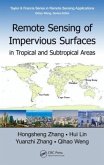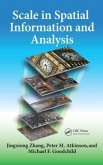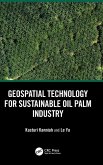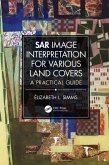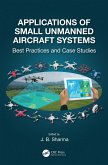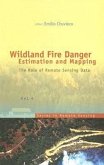Re-envisioning Advances in Remote Sensing
Urbanization, Disasters and Planning
Herausgeber: Singh, Ripudaman
Re-envisioning Advances in Remote Sensing
Urbanization, Disasters and Planning
Herausgeber: Singh, Ripudaman
- Gebundenes Buch
- Merkliste
- Auf die Merkliste
- Bewerten Bewerten
- Teilen
- Produkt teilen
- Produkterinnerung
- Produkterinnerung
This book discusses advances in remote sensing pertaining to urbanization, disasters, and planning, through available geospatial data supported by various case studies. It covers urbanization and its impact, geospatial technology for disasters and urban management, and natural disasters, models, and planning applications including GPS devices.
Andere Kunden interessierten sich auch für
![Remote Sensing of Impervious Surfaces in Tropical and Subtropical Areas Remote Sensing of Impervious Surfaces in Tropical and Subtropical Areas]() Hongsheng ZhangRemote Sensing of Impervious Surfaces in Tropical and Subtropical Areas176,99 €
Hongsheng ZhangRemote Sensing of Impervious Surfaces in Tropical and Subtropical Areas176,99 €![Environmental Remote Sensing and Systems Analysis Environmental Remote Sensing and Systems Analysis]() Environmental Remote Sensing and Systems Analysis220,99 €
Environmental Remote Sensing and Systems Analysis220,99 €![Scale in Spatial Information and Analysis Scale in Spatial Information and Analysis]() Jingxiong ZhangScale in Spatial Information and Analysis276,99 €
Jingxiong ZhangScale in Spatial Information and Analysis276,99 €![Geospatial Technology for Sustainable Oil Palm Industry Geospatial Technology for Sustainable Oil Palm Industry]() Kasturi KanniahGeospatial Technology for Sustainable Oil Palm Industry166,99 €
Kasturi KanniahGeospatial Technology for Sustainable Oil Palm Industry166,99 €![SAR Image Interpretation for Various Land Covers SAR Image Interpretation for Various Land Covers]() Elizabeth L SimmsSAR Image Interpretation for Various Land Covers153,99 €
Elizabeth L SimmsSAR Image Interpretation for Various Land Covers153,99 €![Applications of Small Unmanned Aircraft Systems Applications of Small Unmanned Aircraft Systems]() Applications of Small Unmanned Aircraft Systems174,99 €
Applications of Small Unmanned Aircraft Systems174,99 €![Wildland Fire Danger Estimation and Mapping: The Role of Remote Sensing Data Wildland Fire Danger Estimation and Mapping: The Role of Remote Sensing Data]() Wildland Fire Danger Estimation and Mapping: The Role of Remote Sensing Data170,99 €
Wildland Fire Danger Estimation and Mapping: The Role of Remote Sensing Data170,99 €-
-
-
This book discusses advances in remote sensing pertaining to urbanization, disasters, and planning, through available geospatial data supported by various case studies. It covers urbanization and its impact, geospatial technology for disasters and urban management, and natural disasters, models, and planning applications including GPS devices.
Hinweis: Dieser Artikel kann nur an eine deutsche Lieferadresse ausgeliefert werden.
Hinweis: Dieser Artikel kann nur an eine deutsche Lieferadresse ausgeliefert werden.
Produktdetails
- Produktdetails
- Verlag: Taylor & Francis Ltd (Sales)
- Seitenzahl: 294
- Erscheinungstermin: 17. März 2022
- Englisch
- Abmessung: 234mm x 156mm x 19mm
- Gewicht: 617g
- ISBN-13: 9781032124575
- ISBN-10: 1032124571
- Artikelnr.: 62571978
- Herstellerkennzeichnung
- Libri GmbH
- Europaallee 1
- 36244 Bad Hersfeld
- gpsr@libri.de
- Verlag: Taylor & Francis Ltd (Sales)
- Seitenzahl: 294
- Erscheinungstermin: 17. März 2022
- Englisch
- Abmessung: 234mm x 156mm x 19mm
- Gewicht: 617g
- ISBN-13: 9781032124575
- ISBN-10: 1032124571
- Artikelnr.: 62571978
- Herstellerkennzeichnung
- Libri GmbH
- Europaallee 1
- 36244 Bad Hersfeld
- gpsr@libri.de
Ripudaman Singh, presently teaching as Professor of Geography at Amity University, Noida (Since September 2021). After completing his doctoral research from Panjab University, Chandigarh through UGC-JRF/SRF fellowships, he has been faculty to various institutions including Post Graduate Government College, Sector-11, Chandigarh (2005-2010); Central University of Punjab, Bathinda (2010-2011); and Lyallpur Khalsa College, Jalandhar (2011-2012), and Lovely Professional University, Phagwara (2012 to 2021). He has also served Government College, Hoshiarpur (2004) on honorary basis and Panjab University, Chandigarh as Guest Faculty (2005-2006). He has been a recipient of 'Young Geographers Award' from National Association of Geographers, India (NAGI) in 2005. He has special interest in Development Geography, Remote Sensing & GIS, Geography of India, Political Geography, Regional Development & Planning and Disaster Management. He has published more than sixty research papers in reputed international and national journals and four books to his credit. His other two books are under publication.
Introduction: Re-envisioning Advances in Remote Sensing. Section I.
Urbanization and its Impact. 1. Remote Sensing Applications in Urbanization
and its impact on Environment: A Case Study of Noida City. 2. Dynamics of
Urban Land Use and its Impact on Land Surface Temperature (LST) in Aligarh
City, Uttar Pradesh. 3. Use of a Smartphone to Map Noise Pollution: A Case
Study of Ludhiana City. 4. An Assessment of Urban Green Spaces under the
Smart Cities Mission: The Case of Qaiserbagh ABD Area of Lucknow City. 5.
Impact on Land Surface Temperature and Urban Heat Island Due to Land Use
Land Cover Change in Dhaka Metropolitan Area Using Remote Sensing and GIS
Techniques. Section II. Geospatial Technology for Disaster Management. 6.
Spatio-Environmental Distribution of Drought Disaster Events: A Space-Based
Approach using Terra-MODIS Vegetation Index. 7. Sustainable Management of
Waterlogged and Salt Affected Areas through Geo-Spatial Technology -A Case
Study of Central Haryana. 8. Flood Risk Assessment and Analysis of Kashmir
Valley Floor through Remote Sensing. 9. Remote Sensing Applications in
Landslide Susceptibility Index Mapping of Rangamati District, Bangladesh.
10. Remote Sensing Applications in Landslide Assessments: Case of Kotropi
in Himachal Himalayas. 11. Geospatial techniques to quantify urban change:
A case of Harare, Zimbabwe. Section III. Remote Sensing Applications in
Models and Planning. 12. Remote Sensing & GIS based Site Identification for
Solid Waste Management for Urban Planning of Amritsar Municipal
Corporation, Punjab, India. 13. Use of Remote Sensing Techniques in Land
Degradation Mapping. 14. Feasibility Analysis of a Railway Route using
Remote Sensing/Geoinformatics and Analytical Hierarchy Process (AHP)
Techniques. 15. Comparing Performance of Inverse Distance Weighting and
Modified Shepard Interpolation Models with Different Sampling Arrangements:
A Case Study. 16. Application of Remote Sensing in the Groundwater
Potential Analysis of Developing Countries. 17. Village Identification on
the basis of Intensity of Problems in Physical Resources in the Kandi
Region of Punjab for Micro Level Planning. Conclusion: Outlook to Future
Research Agenda.
Urbanization and its Impact. 1. Remote Sensing Applications in Urbanization
and its impact on Environment: A Case Study of Noida City. 2. Dynamics of
Urban Land Use and its Impact on Land Surface Temperature (LST) in Aligarh
City, Uttar Pradesh. 3. Use of a Smartphone to Map Noise Pollution: A Case
Study of Ludhiana City. 4. An Assessment of Urban Green Spaces under the
Smart Cities Mission: The Case of Qaiserbagh ABD Area of Lucknow City. 5.
Impact on Land Surface Temperature and Urban Heat Island Due to Land Use
Land Cover Change in Dhaka Metropolitan Area Using Remote Sensing and GIS
Techniques. Section II. Geospatial Technology for Disaster Management. 6.
Spatio-Environmental Distribution of Drought Disaster Events: A Space-Based
Approach using Terra-MODIS Vegetation Index. 7. Sustainable Management of
Waterlogged and Salt Affected Areas through Geo-Spatial Technology -A Case
Study of Central Haryana. 8. Flood Risk Assessment and Analysis of Kashmir
Valley Floor through Remote Sensing. 9. Remote Sensing Applications in
Landslide Susceptibility Index Mapping of Rangamati District, Bangladesh.
10. Remote Sensing Applications in Landslide Assessments: Case of Kotropi
in Himachal Himalayas. 11. Geospatial techniques to quantify urban change:
A case of Harare, Zimbabwe. Section III. Remote Sensing Applications in
Models and Planning. 12. Remote Sensing & GIS based Site Identification for
Solid Waste Management for Urban Planning of Amritsar Municipal
Corporation, Punjab, India. 13. Use of Remote Sensing Techniques in Land
Degradation Mapping. 14. Feasibility Analysis of a Railway Route using
Remote Sensing/Geoinformatics and Analytical Hierarchy Process (AHP)
Techniques. 15. Comparing Performance of Inverse Distance Weighting and
Modified Shepard Interpolation Models with Different Sampling Arrangements:
A Case Study. 16. Application of Remote Sensing in the Groundwater
Potential Analysis of Developing Countries. 17. Village Identification on
the basis of Intensity of Problems in Physical Resources in the Kandi
Region of Punjab for Micro Level Planning. Conclusion: Outlook to Future
Research Agenda.
Introduction: Re-envisioning Advances in Remote Sensing. Section I.
Urbanization and its Impact. 1. Remote Sensing Applications in Urbanization
and its impact on Environment: A Case Study of Noida City. 2. Dynamics of
Urban Land Use and its Impact on Land Surface Temperature (LST) in Aligarh
City, Uttar Pradesh. 3. Use of a Smartphone to Map Noise Pollution: A Case
Study of Ludhiana City. 4. An Assessment of Urban Green Spaces under the
Smart Cities Mission: The Case of Qaiserbagh ABD Area of Lucknow City. 5.
Impact on Land Surface Temperature and Urban Heat Island Due to Land Use
Land Cover Change in Dhaka Metropolitan Area Using Remote Sensing and GIS
Techniques. Section II. Geospatial Technology for Disaster Management. 6.
Spatio-Environmental Distribution of Drought Disaster Events: A Space-Based
Approach using Terra-MODIS Vegetation Index. 7. Sustainable Management of
Waterlogged and Salt Affected Areas through Geo-Spatial Technology -A Case
Study of Central Haryana. 8. Flood Risk Assessment and Analysis of Kashmir
Valley Floor through Remote Sensing. 9. Remote Sensing Applications in
Landslide Susceptibility Index Mapping of Rangamati District, Bangladesh.
10. Remote Sensing Applications in Landslide Assessments: Case of Kotropi
in Himachal Himalayas. 11. Geospatial techniques to quantify urban change:
A case of Harare, Zimbabwe. Section III. Remote Sensing Applications in
Models and Planning. 12. Remote Sensing & GIS based Site Identification for
Solid Waste Management for Urban Planning of Amritsar Municipal
Corporation, Punjab, India. 13. Use of Remote Sensing Techniques in Land
Degradation Mapping. 14. Feasibility Analysis of a Railway Route using
Remote Sensing/Geoinformatics and Analytical Hierarchy Process (AHP)
Techniques. 15. Comparing Performance of Inverse Distance Weighting and
Modified Shepard Interpolation Models with Different Sampling Arrangements:
A Case Study. 16. Application of Remote Sensing in the Groundwater
Potential Analysis of Developing Countries. 17. Village Identification on
the basis of Intensity of Problems in Physical Resources in the Kandi
Region of Punjab for Micro Level Planning. Conclusion: Outlook to Future
Research Agenda.
Urbanization and its Impact. 1. Remote Sensing Applications in Urbanization
and its impact on Environment: A Case Study of Noida City. 2. Dynamics of
Urban Land Use and its Impact on Land Surface Temperature (LST) in Aligarh
City, Uttar Pradesh. 3. Use of a Smartphone to Map Noise Pollution: A Case
Study of Ludhiana City. 4. An Assessment of Urban Green Spaces under the
Smart Cities Mission: The Case of Qaiserbagh ABD Area of Lucknow City. 5.
Impact on Land Surface Temperature and Urban Heat Island Due to Land Use
Land Cover Change in Dhaka Metropolitan Area Using Remote Sensing and GIS
Techniques. Section II. Geospatial Technology for Disaster Management. 6.
Spatio-Environmental Distribution of Drought Disaster Events: A Space-Based
Approach using Terra-MODIS Vegetation Index. 7. Sustainable Management of
Waterlogged and Salt Affected Areas through Geo-Spatial Technology -A Case
Study of Central Haryana. 8. Flood Risk Assessment and Analysis of Kashmir
Valley Floor through Remote Sensing. 9. Remote Sensing Applications in
Landslide Susceptibility Index Mapping of Rangamati District, Bangladesh.
10. Remote Sensing Applications in Landslide Assessments: Case of Kotropi
in Himachal Himalayas. 11. Geospatial techniques to quantify urban change:
A case of Harare, Zimbabwe. Section III. Remote Sensing Applications in
Models and Planning. 12. Remote Sensing & GIS based Site Identification for
Solid Waste Management for Urban Planning of Amritsar Municipal
Corporation, Punjab, India. 13. Use of Remote Sensing Techniques in Land
Degradation Mapping. 14. Feasibility Analysis of a Railway Route using
Remote Sensing/Geoinformatics and Analytical Hierarchy Process (AHP)
Techniques. 15. Comparing Performance of Inverse Distance Weighting and
Modified Shepard Interpolation Models with Different Sampling Arrangements:
A Case Study. 16. Application of Remote Sensing in the Groundwater
Potential Analysis of Developing Countries. 17. Village Identification on
the basis of Intensity of Problems in Physical Resources in the Kandi
Region of Punjab for Micro Level Planning. Conclusion: Outlook to Future
Research Agenda.

